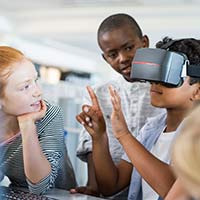The Future Online Classroom: Augmented & Virtual Reality
Nineties babies and their parents might remember the PBS Kids special with Arnold, Carlos, Wanda, Mrs. Frizzle, and a certain magical yellow bus. Together with her class, Mrs. Frizzle would embark on field trips in a school bus to learn about science. The bus would magically transform into different shapes and sizes, and even teleport to different worlds. The class went scuba diving through the digestive system, fluttered alongside butterflies, and even fed dinosaurs.
The Magic School Bus helped kids—both those in Mrs. Frizzle’s fictional class as well as the ones watching at home—learn about science in a more tangible way than they would in a typical classroom. It employed immersive learning, a learning mechanism that places students in an interactive environment to get them excited about science. For example, by traveling through Arnold’s gastrointestinal tract, Mrs. Frizzle’s class was able to understand how the digestive system works in a much more tangible way than if they had read about it in a textbook.
The misconception is that [teachers] have to have a huge budget or that they have to be tech-savvy, but [VR] can be affordable and free and used on the devices they have in the classroom.” – Jaime Donally, Teacher, Author, and Founder of ARVRinEDU
While, unfortunately, The Magic School Bus series is just a cartoon, it was actually years ahead of itself and is a great example of when technology turns magic into reality. No, the physical act of shrinking a yellow school bus is not yet possible, but innovations have made it feasible for students to have experiences similar to those in The Magic School Bus. This technology is called immersive technology, also known as virtual reality.
Expert Interviewee: Jaime Donally – Author, Teacher, and Founder of ARVRinEDU

Jaime Donally started her career as a math teacher and pursued an interest in groundbreaking instructional technologies, including augmented and virtual reality. She began by assisting other educators in her district and later spearheaded global partnerships among educators and institutions worldwide.
Donally offers professional development and instruction in technology around the United States. She published a book entitled Learning Transported: Augmented, Virtual and Mixed Reality for All Classrooms—a resource for those interested in applied immersive technology in education. Notably, she launched ARVRinEDU and continues to help teachers and institutions implement these valuable tools in their classrooms.
Virtual Reality (VR)
Virtual reality is the experience that has been created by the computer to generate a new environment. The concept of virtual reality (VR) is to bring users out of the real world and into a new space, typically through the use of a headset.
Prominent VR products include Oculus Rift, which was bought by Facebook in 2014 for $2 billion—an expensive acquisition that highlights the value of the technology. The same year, Sony built its virtual reality headset for PlayStation and over the next two years, all prominent tech giants had made investments in VR-related products.
While this technology may seem a world away, it is actually used in everyday life. Google Street View is one of the first examples of virtual reality. Users can simply zoom into Google Maps until they are transported onto the street, whether it’s the bustling Champs Elysés or one’s hometown. They can go off the beaten path to explore some of the world wonders like Stonehenge, the Grand Canyon, and the Great Barrier Reef. They can even go inside famous institutions like the White House, Versailles, and the International Space Station.
Augmented Reality (AR)
Other forms of virtual reality include augmented reality and mixed reality. Jaime Donally describes augmented reality as “technology that’s interwoven into your space, a digital layer on top of what you see.” Donally is a VR expert and curator. She researches and tests different educational technology and provides training and staff development on trending technology around the country.
Augmented reality first went mainstream with PokemonGo. This was perhaps the first time most people realized that they were, in fact, using virtual reality. While Google Street View remained slightly static, PokemonGo allowed users to see new things in their own world through an app on their phone. As they walk around with the app open, users stumble upon a Pokemon “in the wild,” which is essentially a computer-generated character that is layered on each user’s reality. Snapchat introduced something similar following the PokemonGo frenzy with virtual layers that users could add to their photos and videos.
Mixed Reality
Mixed reality is the combination of both AR and VR. It is a form of augmented reality where users can interact with computer-generated objects while staying grounded in their world—it blends the real and the virtual.
An example of mixed reality is Google Glass, a pair of smart eyeglasses that would augment what users see through facial recognition, social media sharing, and other technologies. While the first iteration of Google Glass met a tragic fate with consumers due to privacy concerns, it was reborn in 2017 for the enterprise to help workers be more productive and accurate in their work.
Educational Applications of Augmented & Virtual Reality
As virtual reality began to dip its toe into the mainstream, the first obvious use case for immersive technology was gaming. Companies jumped at the lucrative gaming industry to develop new video games that would incorporate this new technology. However, the education industry would soon benefit from VR as well.
“PokemonGo was great because a lot of people started talking about it in education. It allowed us to get the word out and did a good job at making it go mainstream,” explains Donally.
Donally began her career in education as a math teacher after she spent some time coaching sports part-time. As she started teaching math, she realized her love of technology and increasingly used it in her classroom. She was eventually invited to interview for a position in instructional technology support in her district, which is where she realized the huge shift in what was available in the classroom and what could be done using technology.
“At the time, it was common for technology to be emphasized, but teachers didn’t know how to start; they didn’t know how to apply technology in their curriculum,” she recalls. Donally realized that she needed to balance both the tech and education worlds to support educators and impact their curriculum. So she began connecting with companies, providing feedback on what AR and VR might look like in education, and curating products for teachers and schools.
Every day, we find new applications and benefits of AR and VR in the classroom, but some of the primary benefits of the technology include:
- Increased access to information
- Contextualized learning
- Responsive learning
- Inclusivity
Not unlike The Magic School Bus, a VR experience can transport students across time and space, allowing them to a have multisensory and contextualized experience when learning about a certain subject, such as a historical event. Many VR applications also help students with soft skills, such as problem-solving and communication, while also learning about science.
Intel’s Tech Learning Lab, for example, provides a lesson on space where students virtually pilot a spaceship and discover the Milky Way, a black hole, and a comet through first-hand experience while also learning about scientific components. The lab has also created a virtual frog dissection, which the company points out is safer, cost-effective, and more humane.
Affordable Immersive Tech for the Classroom
When an Oculus headset costs upwards of $400 and learning labs remain largely for research purposes, it is easy to think that immersive technology is something only a few can afford. But Google Street View is just one of many free products that teachers can use with the tools they already have.
Imagine teaching children where and how monkeys live by showing them the Virunga National Park in Uganda. A lot of AR and VR tools are immediately available on an iPhone or Android, like Lessons in Herstory, an app that puts a new lens on history by bringing forward the forgotten female heroes in U.S. history textbooks.
“I’m always trying to educate these people that they don’t have to spend a lot of money. Somehow the misconception is that they have to have a huge budget or that they have to be tech-savvy, but [VR] can be affordable and free and used on the devices they have in the classroom,” explains Donally.
For her, the best tools are those that seamlessly integrate into the classroom—not the ones that cost thousands of dollars and require hours of training. When schools make huge investments in technological shifts, it often backfires because there is a steeper learning curve for teachers, no single goal in mind, and the technology is delivered to rather than developed in the classroom.
“If you don’t know your goal, you won’t be successful,” explains Donally. All schools need to identify objectives when implementing technology and not get carried away by the “wow” factor. Teachers and administrators need to work together—rather than there being one designated tech teacher or administrator—to outline specific goals for how immersive technology might address the points that students struggle to understand.
A teacher in Texas used the 4D Anatomy app to help students identify items in the human body and learn about anatomy. “I recently integrated Augmented Reality into a 7th-grade lesson over the human body,” the teacher wrote on Donally’s blog ARVRinEDU.
“We called this our AR Scavenger Hunt! Students were tasked with finding ten anatomical structures such as the clavicle and brain using the 4D Anatomy app by Irusu Technologies. Once located, students took screenshots of their ten structures and placed them on Google Slides to submit for grading. Students had loads for fun finding these structures!”
Similarly, Donally tells the story about her daughter who has dyslexia. Donally was struggling to teach her ten-year-old how to write certain words and would resort to traditional (and not particularly effective) methods of having her write and rewrite the words to remember them. “We were never getting anywhere,” she remembers.
Then, she found the Catchy Words AR app, about which she was doubtful after years of trying to help her daughter with her spelling troubles. But she watched her daughter complete the activities in the app and begin spelling words correctly, not just immediately after, but also retaining the knowledge over the long-term.
“I had to sit back and evaluate what happened in that experience,” says Donally. “A couple of things happened. It was challenging—her brain was struggling, but because her brain had to work so hard, it was not going to do that again. She was going to retain it in the long term. […] What a powerful way for her to recognize by her own disability how she learns and support how she learns by using this technology.”
This is the true value of immersive technology. While teleportation is exciting and certainly offers that “wow” factor, the true benefit of AR, VR, and all other forms of immersive technology is in its responsiveness and its ability to provide students with the autonomy to learn in their own way. A new study by the Georgia Institute of Technology suggests that AR can help young students how to code, especially in tasks that are more interactive and benefit from visual feedback.
The applications of VR in education are too many to list, and they will continue to evolve over time, so the key is in supporting teachers to create maker-spaces and build classrooms based on active learning and students’ passions. As innovation continues to evolve the classroom, teachers will need to be much more adaptable.
“It’s interesting, some educators have to know everything—all the ins and outs—and that’s starting to go away. Kids are owning more of what’s being brought in and teachers are letting go,” Donally says. “Teachers don’t realize how much more effective they can be when students get to pick what they learn. It also takes the pressure off teachers of knowing every little thing and gives them the chance to really showcase what they’re really capable of doing.”

